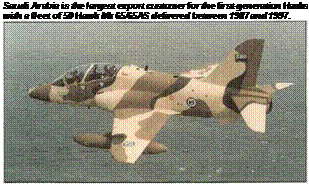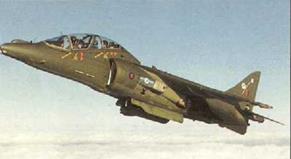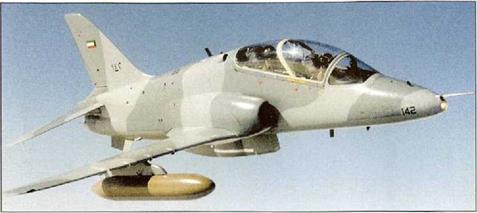BAE SYSTEMS Hawk 50, 60 Advanced jet trainer
|
|
T |
he BAe (Hawker Siddeley) hawk T. Mk 1 trainer
for the RAF first flew in August 1974. It has a low-mounted wing, stepped tandem seats and is powered by a single Adour 151-01 turbofan. It entered service in 1976, replacing Hunter and Gnat advanced trainers. The RAF’s 175 Hawk T. Mk 1s were fitted with three weapons stations as standard for advanced tactical training. In 1983, 89 (including the Red Arrows’ aircraft) were modified to Hawk T. Mk 1A standard as back-up, point-defence fighters with two AIM-9L AAMs and a centreline Aden 30-mm cannon pod. In 1989 BAe launched a re-winging programme for RAF Hawks with 72 wing sets refurbished between 1989 and 1995. In 1998 a rear-fuselage rebuild programme was authorised to extend the structural lives of RAF Hawks until 2010. This work is now being carried out by BAE SYSTEMS, the new name adopted by BAe after its merger with GEC Marconi. A single RAF Hawk T. Mk 1 has been modified to serve as the ASTRA (Advanced System Training Aircraft) Hawk, for variable stability handling training with the Empire Test Pilot’s School.
In 1977 BAe introduced the upgraded Hawk Series 50 export version. The Series 50 is powered by a 23.1-kN (5,200-lb) Adour 851 turbofan which
increased the Hawk’s range and payload performance significantly. Series 50 Hawks are fitted with four underwing pylons and an improved cockpit (including a new weapons control panel). The Hawk Series 50 was sold to Finland (57 Hawk Mk 51/51A aircraft), Indonesia (20 Mk 53), and Kenya (12 Mk 52) The Finnish Hawks were assembled locally by Valmet.
The follow-or Hawk Series 60 export version introduced a 25.4-kN (5,700-lb st) Mk 861 Adour engine, and an ‘advanced wing’ with additional leading-edge fences and revised flaps. Operating weights, range and performance were boosted compared to the Series 50 and the Series 60 aircraft had built-in provision for IR-guided air-to-air missiles (such as the AIM-9 and R.550).
Customers for the Hawk Series 60 include Abu Dhabi (16 Mk 63/Mk 63C aircraft), Dubai [nine Mk 61), Korea (20 Mk 67). Kuwait (12 Mk 64), Saudi Arabia (50 Mk 65/Mk 65A), Switzerland (20 Mk 66) and Zimbabwe (13 Mk 60/Mk 60A Korea’s Hawk Mk 67s are a unique ‘long-nosed1 version, similar to the Hawk 100, with nose-wheel steering. The Swiss Hawks were assembled locally by F&W The related Boeing (McDonnell Douglas) T-45 is described under a separate entry.
 Specification: BAE SYSTEMS Hawk T. Mk 1 Powerplant. one 23.1-kN (5.200-ib) flolls – Reyce/Turbomeca Adour Mk 871 turbofan Dimensions: wing span 9.39 m {30 ft 9X in); length 10.775 m (34 ft 4/f ink height 3.93 m <13 ft И in)
Specification: BAE SYSTEMS Hawk T. Mk 1 Powerplant. one 23.1-kN (5.200-ib) flolls – Reyce/Turbomeca Adour Mk 871 turbofan Dimensions: wing span 9.39 m {30 ft 9X in); length 10.775 m (34 ft 4/f ink height 3.93 m <13 ft И in)
Weights: empty 4400 kg (9.700 lb); maximum take-off 5700 kg (12,56611)1 Performance: maximum level speed ‘clean’ 1065 kmh 1661 mph): maximum rate of climb at sea level 3600 m (11.800 ft) per minute; sarvice ceiling 13545 m (44,500 ft); combat radios 638 km (397 miles) with gun pod. two AIM-9s and four 500-lb bombs Armament: one centreline 30-mm ADEN cannon; maximum ordnance 3000 kg (6,614 lb)

|
T |
he success of the Hawk in the export market convinced British Aerospace (now BAE SYSTEMS) to develop more capable versions for advanced training and front-line combat missions. The first of these to emerge was the Hawk Series 100, an enhanced ground-attack version of the Hawk Series 60. While largely similar to езгііег aircraft, the Hawk 100 introduced an uprated Adour Mk 871 turbofan, an increased span wing (with combat manoeuvre flaps, wingtip missile launch rails and six stores stations), a lengthened nose housing an optional FUR and/or laser rangefinder, an advanced cockpit with HUDWAC, MFDs and HOTAS and attack-optimised avionics. A single 30-mm ADEN gun pod is an optional fitting on the fuselage centreline in place of a further stores station.
The first flight of the (converted) prototype came on 21 October 1987 The first production prototype flew on 29 February 1992. The launch customer for the Hawk 100 was Abu Dhabi, n 1989. Customers to date include Abu Dhabi (18 Mk 102 aircraft), Indonesia (e’ght Mk 109). Malaysia (10 Mk 108) and Oman (four Mk 103).
BAE SYSTEMS has developed a follow-on version of the Hawk 100, the Hawk LIFT (Lead-In Fighter Trainer). This version has a three-screen digital cockpit and other improved onboard systems. The launch customer was South Africa, in 1998, with an order for 24 aircraft. Similar advanced trainers (but not True LIFT aircraft) are being acquired by Canada
The Hawk 200 provides affordable and effective combat power, in a compact package. These aircraft are Omani Hawk Mk 203s.
(18 Mk 115, local designation CT-155.1 and Australia (33 Mk 127. ocal designation A27).
The single-seat Hawk 200 variant retains the Hawk 100’s engine, combat wing and stores capability, but has a redesigned forward fuselage for a single cockpit, a Lockheed Martin AN/APG-66H radar in a reprofiled nose, and two 25-mm ADEN cannon. For self-protection the Hawk 200 is fitted with the Sky Guardian 200 radar warning system and chaff/flare dispensers. The Hawk 200 can be fitted with an air-to-air refuelling probe
A prototype first flew on 24 April 1987, but the full mission fit was first applied to the third development aircraft, which flew on 13 February 1992. The Hawk 200 can undertake air defence, close air support, battlefield interdiction, anti-shipping and photo-reconnaissance missions. Oman became the launch customer, in 1990, but the first production- standard aircraft was delivered to Malaysia, in 1994. Hawk 200 customers include Indonesia (32 Mk 209 aircraft). Malaysia (18 Mk 208) and Oman (12 Mk 203).
The most obvious external changes on the Hawk 100 are its extended ‘chisel’ nose and wingtip air-to-air missile launchers.
 Specification: BAE SYSTEMS Hawk 200 Powerplant: one 26-kN 15,845-lb) Rolls – Royce/Turbomcca Adour Mk 371 turbofan Dimensions: wing span 3.39 m (30 ft 9Л in); ength 10,95 m!35 ft 11 in); height 4,13 m (13 ft 6 К in)
Specification: BAE SYSTEMS Hawk 200 Powerplant: one 26-kN 15,845-lb) Rolls – Royce/Turbomcca Adour Mk 371 turbofan Dimensions: wing span 3.39 m (30 ft 9Л in); ength 10,95 m!35 ft 11 in); height 4,13 m (13 ft 6 К in)
Weights: empty 4440<g (9,810 lb); maximum take-off 91QD kg (20.051 lb|
Performance: maximum level speed ‘clean’ 10Б5 kmh (661 mph); maximum rate of climb at sea level 3503m (11,510 ft) per minute: service ceiling 13715 m (45,000 ft); ferry range 2528 km (1570 miles) with two drop tanks Armament: ore centreline ЗО-глт ADEN cannon, maximum ordnance 3000 kg (6,614 lb)

 |
 |
During ihe late 1970s BAe (now BAE SYSTEMS) initiated independent development of an advanced Harrier. This was abandoned and the Harrier GR. Mk 5 designation was used instead for a licence-built version of the McDonnell Doug as (Boe’rg) AV-8B Harrier II (described separately). for which British Aerospace was a sub-contractor. Two pre-series and 60 production aircraft were ordered, with the first (pre-series) flying in April 1985. Numerous detail differences from the AV-8B were specified by the RAF, with indigenous equipment such as ejection seats, self-defence systems and avionics.
Problems with several systems imposed e two – year delay on RAF service entry and the aircraft were accepted lacking major equipment items, including the new 25-mm ADEN cannon, Zeus ECM system and missile approach warning system. Initial RAF deliveries began in May 1987 and the first squadron was declared operational in November 1989. Nineteen GR. Mk 5s were completed to an interim GR. Mk 5A standard, with provision Jor GR. Mk 7 avionics, and were delivered stra ght into storage to await conversion to full night-attack standard. All remaining GR. Mk 5/5As have now been converted to GR. Mk 7 standard.
The RAF’s two-seat Harrier T. Mk 10s are operated by No. 20(R) squadron which handles the operational conversion task for RAF Harriers.
GR. Mk 7s deployed for operations over Iraq during Operation Warden were painted in this temporary grey finish on fop of their regular camouflage.
The Harrier GR. Mk 7 is the RAF equivalent of the Night Attack AV-8B. Its nose is fitted with a TV/laser target seeker/tracker of the Angle Rate Bombing Sot, and a FLIR is mounted in the housing above. Two forward hemisphere antennas for the Zeus ECM system are located under the nose The Harrier GR. Mk 7 has an NVG-compatibie cockpit with a digital colour map. The RAF ordered 34 new-build"GR. Mk 7s in 1988 and a converted preseries aircraft was first flown as such in November 1989. The first production GR. Mk 7 was delivered in May 1990 and operational service began in late 1992. Along with the new-build aircraft, 41 Harrier GR. Mk 5s and 19 GR. Mk 5As were converted to GR. Mk 7 standard – between 1990 and 1994. The first GR. Mk 7 unit was No. IV Scuadron, which reequipped in September 1990. As a result of operations over Bosnia RAF Harriers have been given a useful reconnaissance caoability using the Vinten GP-1 camera pod.
To augment the GR. Mk 7 force the RAF also acquired 13 two-seat Harrier T. Mk 10 trainers, based on the same next-generation airframe, with common (fully-operational) systems to the GR. Mk 7. The T. Mk 10 prototype first flew on 7 April 1994 and the type entered service in March 1995.
 |
Developed from the RAF’s Harrier GR. Mk 3, the Sea Harrier FRS. Mk 1 introduced a redesigned forward fuselage and nose fitted with a Ferranti Blue Fox radar, a new canopy and raised cockpit for improved view, end a 96.3-kN (21,492- b st! Pegasus Mk 104 engine. Avionics changes included addition of an auto-pilot, в revised nav/ attack system and a new HUD. An initial order was placed in 1975 for 24 FRS. Mk 1s and a single T. Mk 4A trainer. The first operational squadron (No. 899 Sqn) was commissioned in April 1980 and two units (Nos 800 and 801 Sqns) were subsequently deployed during the Falklands War where they served with distinction, scoring 23 confirmed victories.
Post-Falkland attrition replacements and further orders subsequently took total RN procurement up to 57 FRS. Mk 1s and four trainers (including three T. Mk 4Ns). Improvements included revised wing pylons for carriage of four AIM-9Ls (on twin launch mils}, larger-capacity drop tanks and installation of an improved Blue Fox radar and RWR. In 1978, the Indian Navy became the second Sea Harrier operator, ordering a total of 24 FRS. Mk 51s and four T. Mk 60 trainers.
A mid-life update was initiated in 1985 to refine the Sea Harrier as a more capable interceptor. BAe (now BAE SYSTEMS) converted two FRS. Mk is to serve as FRS. Mk 2 prototypes, with the first flying in September 1988, Despite the addition of an extra equipment bay and a recootoured nose to house
The Royal Navy’s Fleet Air Arm has two front-line Sea Harrier FA. Mk 2 squadrons, Nos. 800 and No. 801 Sqns, plus the training Squadron No 899.
the Blue Vixen multi-mode pulse-Doppler radar (giving compatibi ity with the AIM-120 AMRAAM), the FRS. Mk 2 is actually nearly 0.61 m (2 ft) shorter overall due to the elimination of the FRS. Mk 1’s pitot probe. The cockpit introduces new multi-function CRT displays and HQTAS controls. The FRS. Mk 2 designation was changed to F/A. Mk 2 in May 1994 and then to the current FA. Mk 2 in 1995.
Two development aircraft were built, with the first flying on September 1988. The contract for the modification of 29 existing FRS. Mk Is to Sea Harrier FA. Mk 2 standard was signed in December 1988, and was followed by a further tour aircraft in 1994. Another 18 new-build FA. Mk 2s were also acquired, and delivered between 1995 and 1998. Seven T. Mlk 4/4N trainers have been converted to Sea Harrier T. Mk 8 standard, to meet the requirement for FA. Mk 2 training. In August 1994 No. 899 San embarked four FA. Mk 2s aboard HMS Invincible for operations over Bosnia, and No, 801 Sqn made the first full deployment of the FA. Mk 2 in January 1995, aboard HMS Illustrious.
The Sea Harrier T. Mk 8 trainer is an upgraded version of the earlier T. Mk 4 fitted with some of the systems of the FA. Mk 2 – though it lacks a radar.
|

United Kingdom












